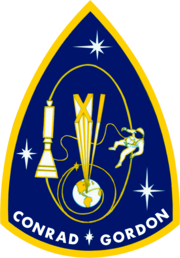 Gemini XI conducting a tether experiment using the Agena Target Vehicle | |
| Mission type | |
|---|---|
| Operator | NASA |
| COSPAR ID | 1966-081A |
| SATCAT no. | 02415 |
| Mission duration | 2 days, 23 hours, 17 minutes and 9 seconds |
| Orbits completed | 44 |
| Spacecraft properties | |
| Spacecraft | Gemini SC11 |
| Manufacturer | McDonnell Aircraft |
| Launch mass | 3,798 kg (8,374 lb) |
| Landing mass | 1,920 kg (4,230 lb) |
| Crew | |
| Crew size | 2 |
| Members | |
| EVAs | 2 |
| EVA duration | 2 hours and 41 minutes |
| Start of mission | |
| Launch date | September 12, 1966, 14:42:26 UTC (9:42:26 am EST) |
| Rocket | Titan II GLV |
| Launch site | Cape Kennedy, LC-19 |
| End of mission | |
| Recovered by | USS Guam |
| Landing date | September 15, 1966, 13:59:35 UTC |
| Landing site | Atlantic Ocean (24°15′N 70°0′W / 24.250°N 70.000°W) |
| Orbital parameters | |
| Reference system | Geocentric orbit |
| Regime | Low Earth orbit |
| Perigee altitude | 298 km (185 mi; 161 nmi) |
| Apogee altitude | 1,374 km (854 mi; 742 nmi) |
| Inclination | 28.8° |
| Period | 101.57 minutes |
| Epoch | September 14, 1966[1] |
| Docking with GATV-5006 | |
| Docking date | September 12, 1966, 16:16:00 UTC |
| Undocking date | September 14, 1966, 16:55:00 UTC |
| Time docked | 2 days and 39 minutes |
 Mission patch  Gordon and Conrad | |
Gemini 11 (officially Gemini XI)[2] was the ninth crewed spaceflight mission of NASA's Project Gemini, which flew from September 12 to 15, 1966. It was the 17th crewed American flight and the 25th spaceflight to that time (includes X-15 flights over 100 kilometers (54 nmi)). Astronauts Pete Conrad and Dick Gordon performed the first direct-ascent (first orbit) rendezvous with an Agena Target Vehicle, docking with it 1 hour 34 minutes after launch; used the Agena rocket engine to achieve a record high-apogee Earth orbit; and created a small amount of artificial gravity by spinning the two spacecraft connected by a tether. Gordon also performed two extra-vehicular activities for a total of 2 hours 41 minutes.
- ^ McDowell, Jonathan. "SATCAT". Jonathan's Space Pages. Retrieved March 23, 2014.
- ^ Hacker, Barton C.; Grimwood, James M. (September 1974). "Chapter 11 Pillars of Confidence". On the Shoulders of Titans: A History of Project Gemini. NASA History Series. Vol. SP-4203. NASA. p. 239. Archived from the original on 2010-01-13. Retrieved 2013-09-26. With Gemini IV, NASA changed to Roman numerals for Gemini mission designations.